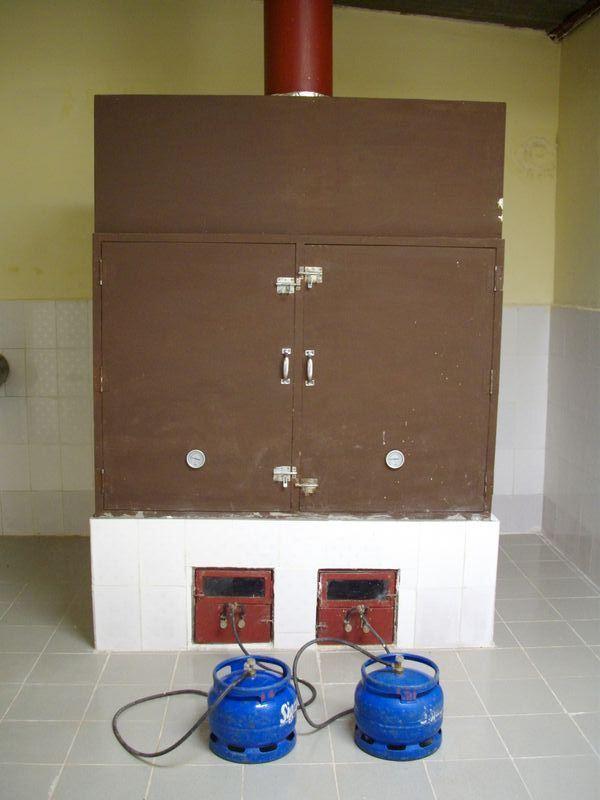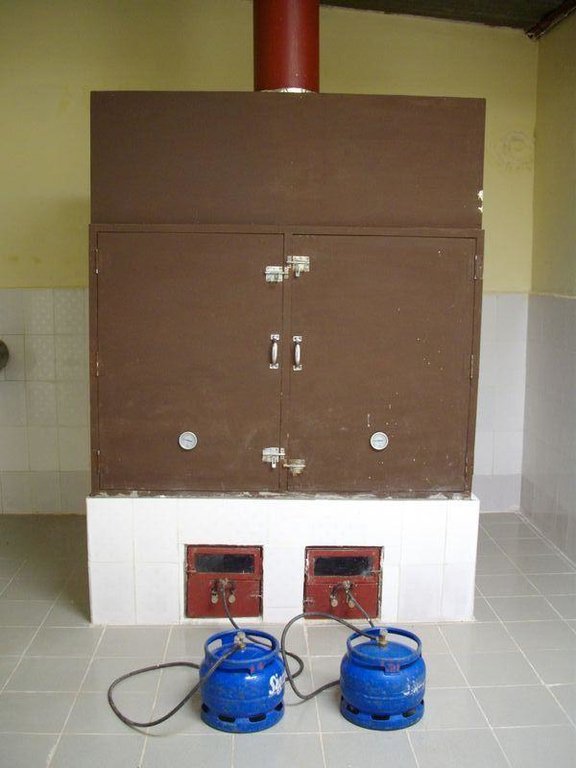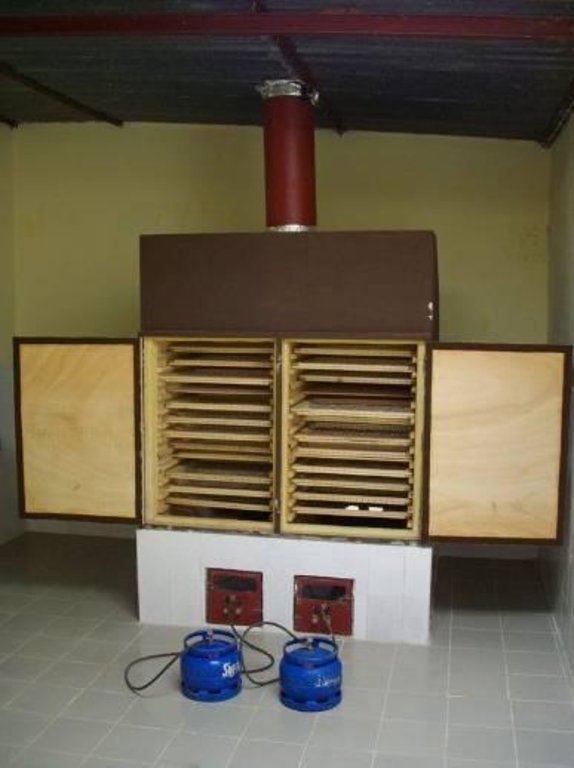Using gas dryers (Atesta-Sikasso) to process animal and vegetable products [Mali]
- Creation:
- Update:
- Compiler: Dieter Nill
- Editor: –
- Reviewers: Fabian Ottiger, Alexandra Gavilano
Utilisation du séchoir a gaz (type Atesta-Sikasso) pour traitement des produits d’origine végétale et animale (French)
technologies_1641 - Mali
View sections
Expand all Collapse all1. General information
1.2 Contact details of resource persons and institutions involved in the assessment and documentation of the Technology
SLM specialist:
Assarki Oumar
Agricultural Competitiveness and Diversification Programme (PCDA)
Mali
Name of project which facilitated the documentation/ evaluation of the Technology (if relevant)
Manual of Good Practices in Small Scale Irrigation in the Sahel (GIZ )Name of the institution(s) which facilitated the documentation/ evaluation of the Technology (if relevant)
Agricultural Competitiveness and Diversification Programme (PCDA) - MaliName of the institution(s) which facilitated the documentation/ evaluation of the Technology (if relevant)
Deutsche Gesellschaft für Internationale Zusammenarbeit (GIZ) - Germany1.3 Conditions regarding the use of data documented through WOCAT
The compiler and key resource person(s) accept the conditions regarding the use of data documented through WOCAT:
Yes
2. Description of the SLM Technology
2.1 Short description of the Technology
Definition of the Technology:
This multipurpose dryer is used to dry animal and vegetable products (mango, tomato, coconut, ginger, meat, etc.).
2.2 Detailed description of the Technology
Description:
It comprises: 2 compartments, 2 thermometers, 4 burners, 20 trays and 4 baffles. The drying process is natural (natural convection). Moving produce around the unit (top to bottom, back to front) every two hours helps homogenise the drying process.
Purpose of the Technology: The objectives of using a dryer are: to improve productivity and the quality of dried mango; to demonstrate the technical and economic benefits of the system; to promote the use of Atesta dryers among processing outfits. There are reduced drying times (100 kilograms of pulp in 20 hours) and improved product quality (good colour and taste). The total output quantity from each production cycle is 14 kilograms of dried mango from 100 kilograms of mango pulp / output quality: 10 kilograms prime quality, 4 kilograms secondary quality. A minimum quantity of 524 kilograms must be produced to make the activity profitable. The dryer has a lifespan of five years.
Establishment / maintenance activities and inputs: Source and quantity of energy used: 12 kilograms of gas in 24 hours. Duration of machine operation: 20 hours per production cycle. Drying temperature: 70 to 80ºC. Water content of end product: 15%. Duration of activities: 24 hours. Type of raw material: fresh mango. Receipt/sorting/weighing of raw material: 100 kilograms of mango pulp per production cycle. Cleaning and preparing the raw material: washing in chlorinated water (3 to 5 drops per litre), peeling, stone removal, and cutting into slices one to five millimetres thick. Processing operations: Packaging the final product in plastic sachets of 100, 200 and 500 grams, and one kilogram.
Implementation: The dryer is on show at Ségou demonstration centre where promoters come and express their interest. Interested parties then apply to PCDA. These applications are reviewed by the Regional Centre for the Approval of Sub-Projects (CRAP), which comprises the governor, banks, research and oversight bodies (ROBs) and inter-branch organisations. Once approved by CRAP, the project must subsequently be approved by the National Centre for the Approval of Sub-Projects (CNAP) in Bamako. Successful promoters are informed and then pay their contribution. PCDA and the ROBs provide training and support, and carry out monitoring. Part of the training involves exchange trips to visit promoters outside the region. Roles of the actors involved: PCDA promotes innovations, subsidises financing, provides support and undertakes evaluation. ROBs carry out studies, monitoring and reporting, and support promoters. Banks/microfinance institutions provide co-funding and loans, and train up promoters. Promoters contribute financially to their training and implement the project.
2.3 Photos of the Technology
2.5 Country/ region/ locations where the Technology has been applied and which are covered by this assessment
Country:
Mali
Region/ State/ Province:
Mali
Further specification of location:
Sikasso town, Bougouni, Koutiala, Bamako and Ségou
Comments:
Around 20 units installed
2.6 Date of implementation
If precise year is not known, indicate approximate date:
- less than 10 years ago (recently)
2.7 Introduction of the Technology
Specify how the Technology was introduced:
- through projects/ external interventions
Comments (type of project, etc.):
Since 2005, through Agricultural Competitiveness and Diversification Programme (PCDA)
3. Classification of the SLM Technology
3.1 Main purpose(s) of the Technology
- create beneficial economic impact
- create beneficial social impact
3.2 Current land use type(s) where the Technology is applied
Land use mixed within the same land unit:
Yes
Specify mixed land use (crops/ grazing/ trees):
- Agro-pastoralism (incl. integrated crop-livestock)

Cropland
- Annual cropping
- rice
Number of growing seasons per year:
- 1
Specify:
Longest growing period in days: 120 Longest growing period from month to month: August-November

Grazing land

Settlements, infrastructure
- Settlements, buildings
Comments:
Major land use problems (compiler’s opinion): low quantity and quality of dried animal products and vegetables
Mixed: (eg agro-pastoralism, silvo-pastoralism): Yes
Livestock density: 1-10 LU /km2
3.4 Water supply
Water supply for the land on which the Technology is applied:
- mixed rainfed-irrigated
3.5 SLM group to which the Technology belongs
- post-harvest measures
3.6 SLM measures comprising the Technology

management measures
- M7: Others
Comments:
Main measures: management measures
Specification of other management measures: gas dryer
3.7 Main types of land degradation addressed by the Technology

other
Specify:
Main causes of degradation: crop management (annual, perennial, tree/shrub), urbanisation and infrastructure development
3.8 Prevention, reduction, or restoration of land degradation
Specify the goal of the Technology with regard to land degradation:
- prevent land degradation
4. Technical specifications, implementation activities, inputs, and costs
4.1 Technical drawing of the Technology
Technical specifications (related to technical drawing):
Technical knowledge required for field staff / advisors: high
Technical knowledge required for land users: moderate (Need for a certain level of technical know-how (regulating temperatures, following technical procedures, etc.))
Main technical functions: promotion of vegetation species and varieties (quality, eg palatable fodder), Reduction in drying times, Improved product quality and quantity
Other type of management: gas dryer
4.2 General information regarding the calculation of inputs and costs
other/ national currency (specify):
CFA Franc
If relevant, indicate exchange rate from USD to local currency (e.g. 1 USD = 79.9 Brazilian Real): 1 USD =:
517.0
4.3 Establishment activities
| Activity | Timing (season) | |
|---|---|---|
| 1. | Interested parties apply for dryer and pay their contribution | |
| 2. | Training (involves exchange trips to visit promoters outside the region) |
4.5 Maintenance/ recurrent activities
| Activity | Timing/ frequency | |
|---|---|---|
| 1. | Drying process: Receipt/sorting/weighing of raw material: 100 kilograms of mango pulp per production cycle. Cleaning and preparing the raw material: washing in chlorinated water (3 to 5 drops per litre), peeling, stone removal, and cutting into slices one to five millimetres thick. | |
| 2. | Processing operations: Packaging the final product in plastic sachets of 100, 200 and 500 grams, and one kilogram. |
4.7 Most important factors affecting the costs
Describe the most determinate factors affecting the costs:
Investment costs: 1,760,000 CFA Francs (3,376 Dollar).
Turnover = total production x unit price = 3,975,000 CFA Francs. Production cost (CFA francs/kilogram) = (variable costs + fixed costs) / output quantity = (2,428,000 + 460,000) = 2,888,000 CFA francs / 1,400 kilograms = 2,063 CFA Francs; Net return = turnover - total cost of production = 3,975,000 - 2,888,000 = 1,087,000 CFA Francs; Contribution margin = turnover - variable costs = 3,975,000 - 2,428,000 = 1,547,000 CFA Francs; Contribution margin rate = contribution margin / turnover = 1,547,000 / 3,975,000 CFA francs = 39%; Production costs: each kilogram of processed dried mango incurs a cost of 2,063 CFA Francs; Break-even point in terms of quantity: a minimum quantity of 524 kilograms must be produced to make the activity profitable
5. Natural and human environment
5.1 Climate
Annual rainfall
- < 250 mm
- 251-500 mm
- 501-750 mm
- 751-1,000 mm
- 1,001-1,500 mm
- 1,501-2,000 mm
- 2,001-3,000 mm
- 3,001-4,000 mm
- > 4,000 mm
Agro-climatic zone
- semi-arid
Thermal climate class: tropics
5.2 Topography
Slopes on average:
- flat (0-2%)
- gentle (3-5%)
- moderate (6-10%)
- rolling (11-15%)
- hilly (16-30%)
- steep (31-60%)
- very steep (>60%)
Landforms:
- plateau/plains
- ridges
- mountain slopes
- hill slopes
- footslopes
- valley floors
Altitudinal zone:
- 0-100 m a.s.l.
- 101-500 m a.s.l.
- 501-1,000 m a.s.l.
- 1,001-1,500 m a.s.l.
- 1,501-2,000 m a.s.l.
- 2,001-2,500 m a.s.l.
- 2,501-3,000 m a.s.l.
- 3,001-4,000 m a.s.l.
- > 4,000 m a.s.l.
5.3 Soils
Soil depth on average:
- very shallow (0-20 cm)
- shallow (21-50 cm)
- moderately deep (51-80 cm)
- deep (81-120 cm)
- very deep (> 120 cm)
Soil texture (topsoil):
- medium (loamy, silty)
- fine/ heavy (clay)
Topsoil organic matter:
- medium (1-3%)
- low (<1%)
If available, attach full soil description or specify the available information, e.g. soil type, soil PH/ acidity, Cation Exchange Capacity, nitrogen, salinity etc.
Soil fertility: Medium
Soil drainage/infiltration: Medium and poor
Soil water storage capacity: Medium
5.4 Water availability and quality
Ground water table:
5-50 m
Availability of surface water:
medium
Water quality (untreated):
for agricultural use only (irrigation)
Comments and further specifications on water quality and quantity:
Availability of surface water: Also poor/ none
5.5 Biodiversity
Species diversity:
- medium
Comments and further specifications on biodiversity:
Species diversity: Also low
5.6 Characteristics of land users applying the Technology
Market orientation of production system:
- mixed (subsistence/ commercial)
Off-farm income:
- 10-50% of all income
Relative level of wealth:
- poor
- average
Level of mechanization:
- manual work
Gender:
- men
Indicate other relevant characteristics of the land users:
Population density: < 10 persons/km2
Annual population growth: 2% - 3%
10% of the land users are rich.
50% of the land users are average wealthy.
30% of the land users are poor.
10% of the land users are poor.
5.7 Average area of land used by land users applying the Technology
- < 0.5 ha
- 0.5-1 ha
- 1-2 ha
- 2-5 ha
- 5-15 ha
- 15-50 ha
- 50-100 ha
- 100-500 ha
- 500-1,000 ha
- 1,000-10,000 ha
- > 10,000 ha
Is this considered small-, medium- or large-scale (referring to local context)?
- small-scale
5.8 Land ownership, land use rights, and water use rights
Comments:
The irrigated land is allocated by the chief
5.9 Access to services and infrastructure
health:
- poor
- moderate
- good
education:
- poor
- moderate
- good
technical assistance:
- poor
- moderate
- good
employment (e.g. off-farm):
- poor
- moderate
- good
markets:
- poor
- moderate
- good
energy:
- poor
- moderate
- good
roads and transport:
- poor
- moderate
- good
drinking water and sanitation:
- poor
- moderate
- good
financial services:
- poor
- moderate
- good
6. Impacts and concluding statements
6.1 On-site impacts the Technology has shown
Socio-economic impacts
Production
land management
Income and costs
farm income
Other socio-economic impacts
Product quality
Comments/ specify:
Increased quality and quantity of dry animal products and vegetables
Socio-cultural impacts
food security/ self-sufficiency
Improved livelihoods and human well-being
Comments/ specify:
Reduced drying times and improved product quality. Each kilogram of processed dried mango incurs a cost of 2,063 CFA Francs; break-even point in terms of quantity: a minimum quantity of 524 kilograms must be produced to make the activity profitable.
Ecological impacts
Other ecological impacts
Efficiency
Comments/ specify:
more efficient use of resources (e.g. food products), reduced pressure on land
6.3 Exposure and sensitivity of the Technology to gradual climate change and climate-related extremes/ disasters (as perceived by land users)
Gradual climate change
Gradual climate change
| Season | increase or decrease | How does the Technology cope with it? | |
|---|---|---|---|
| annual temperature | increase | well |
Climate-related extremes (disasters)
Meteorological disasters
| How does the Technology cope with it? | |
|---|---|
| local rainstorm | well |
| local windstorm | well |
Climatological disasters
| How does the Technology cope with it? | |
|---|---|
| drought | well |
Hydrological disasters
| How does the Technology cope with it? | |
|---|---|
| general (river) flood | well |
Other climate-related consequences
Other climate-related consequences
| How does the Technology cope with it? | |
|---|---|
| reduced growing period | well |
6.4 Cost-benefit analysis
How do the benefits compare with the establishment costs (from land users’ perspective)?
Short-term returns:
slightly positive
Long-term returns:
positive
How do the benefits compare with the maintenance/ recurrent costs (from land users' perspective)?
Short-term returns:
positive
Long-term returns:
positive
6.7 Strengths/ advantages/ opportunities of the Technology
| Strengths/ advantages/ opportunities in the compiler’s or other key resource person’s view |
|---|
| Reduced drying times: 100 kilograms of pulp in 20 hours |
| Improved product quality: good colour and taste |
| Total output quantity from each production cycle: 14 kilograms of dried mango from 100 kilograms of mango pulp / output quality: 10 kilograms prime quality, 4 kilograms secondary quality |
| Creation by promoters of a ‘drying school’ in Sikasso |
6.8 Weaknesses/ disadvantages/ risks of the Technology and ways of overcoming them
| Weaknesses/ disadvantages/ risks in the compiler’s or other key resource person’s view | How can they be overcome? |
|---|---|
| Material constraints: sourcing gas and appropriate packaging (availability, airtightness, etc.) | |
| gas supply problems: large gas bottles not subsidised by the state (only small bottles are) | |
| Need for a certain level of technical know-how (regulating temperatures, following technical procedures, etc.) |
7. References and links
7.1 Methods/ sources of information
7.2 References to available publications
Title, author, year, ISBN:
Agricultural Competitiveness and Diversification Programme (PCDA) (2008): Référentiel technico-économique. Séchage de la mangue au séchoir à gaz, Atesta-Sikasso [Technical and economic reference document: Drying mango with a gas dryer (Atesta-Sikasso)]
7.3 Links to relevant online information
Title/ description:
Manual of Good Practices in Small Scale Irrigation in the Sahel. Experiences from Mali. Published by GIZ in 2014.
URL:
http://star-www.giz.de/starweb/giz/pub/servlet.starweb
Links and modules
Expand all Collapse allLinks
No links
Modules
No modules




